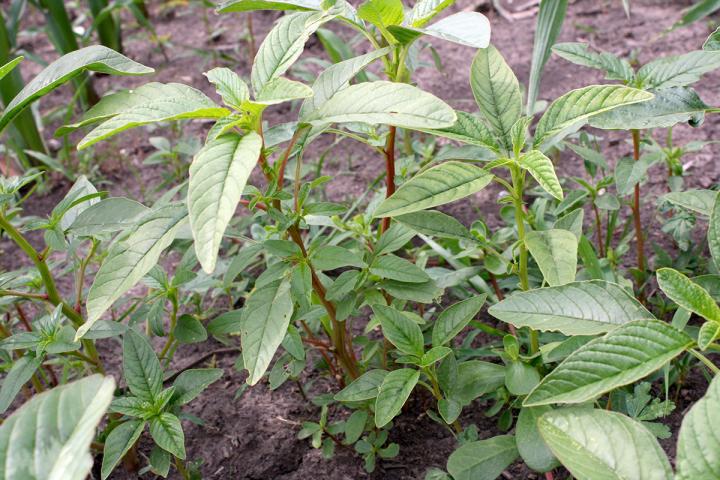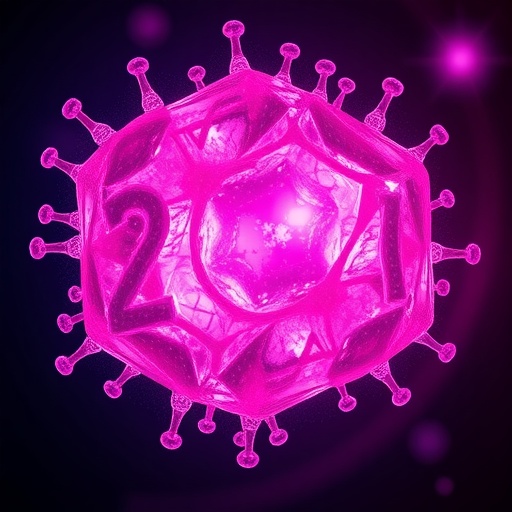
Credit: Lauren D. Quinn, University of Illinois
URBANA, Ill. – Like antibiotic-resistant bacteria, some herbicide-resistant weeds can’t be killed by available chemicals. The problem affects more than just the errant weed in our driveways; herbicide-resistant weeds threaten our food supply, stealing resources and outcompeting the crops that make up our breakfast cereal and feed the nation’s livestock.
The weed that represents the biggest threat to Midwestern corn and soybean production, waterhemp, has outsmarted almost every kind of herbicide on the market today.
University of Illinois scientists are working to reveal waterhemp’s tricks. Through years of research, they discovered the weed can ramp up production of detoxifying enzymes that neutralize certain herbicides before they can disrupt essential cellular processes. Metabolic resistance, as this strategy is known, is just one process by which waterhemp evades herbicides. Unfortunately, because there may be hundreds of detoxifying enzymes involved, metabolic resistance is hard to identify and even harder to combat.
In two recent studies, Illinois researchers explain metabolic resistance to three commonly used herbicides in waterhemp, getting closer to finding important genetic cues. Results also confirm the importance of using a multi-pronged approach to waterhemp control.
“These waterhemp populations are adapting and evolving incredible abilities to metabolize everything. It’s bad news, but at least we understand the mechanisms better. And ultimately, that understanding could potentially be exploited to use waterhemp’s metabolic arsenal against itself,” says Dean Riechers, professor in the Department of Crop Sciences at Illinois and co-author on both studies. “That’s one interesting way our research could be directly applied to controlling this weed.”
Last year, Illinois researchers documented resistance to Group 15 herbicides in waterhemp. This group of herbicides, including S-metolachlor, targets very-long-chain fatty acid production in sensitive plants. The researchers suspected it was also a case of metabolic resistance, and the Illinois team, led by graduate student Seth Strom, has now confirmed it in a study published in Pest Management Science.
“We were the first group in the world to show resistance to Group 15 herbicides in waterhemp, and now we have identified the mechanism behind it,” Riechers says. “Again, it’s not good news because it means we’re running out of herbicides, and in this case it involves pre-emergence herbicides.”
The study suggests two classes of detoxifying enzymes, known as GSTs and P450s, appear to neutralize S-metolachlor in resistant waterhemp.
Group 15 herbicides can be safely used in corn because the crop uses GSTs to naturally detoxify the chemicals; in other words, corn has a natural tolerance to these chemicals. Strom’s research suggests waterhemp is not only able to mimic corn’s natural detoxification mechanism, but it evolved an additional way to avoid being harmed by S-metolachlor.
Honing in on the two classes of detoxifying enzymes is not the end of the story, however. Because plants have hundreds of enzymes in each class, the researchers have more work ahead of them to identify the specific genes that are activated.
In a separate study, Riechers and another group of Illinois scientists revealed more of waterhemp’s metabolic secrets.
“We have known for the last 10 years that whenever we see waterhemp with resistance to an HPPD inhibitor in the field, such as mesotrione, it has always shown metabolic atrazine resistance, too. However, it is possible for waterhemp to be resistant to atrazine and not mesotrione,” Riechers says.
The apparent association between mesotrione and metabolic atrazine resistance could be coincidental, but given how often the resistances co-occur, Riechers thought the genes controlling resistance for the two chemicals might be shared or linked.
In a study published in Weed Science, graduate student Kip Jacobs demonstrated an overlap in the genes responsible for metabolic atrazine and mesotrione resistance. Because researchers already knew the single gene for metabolic atrazine resistance, the results get them closer to understanding the genes conferring mesotrione resistance.
“Whenever we find out whether it’s two or three or four genes involved in mesotrione resistance, our results tell us one of them should be the metabolic atrazine resistance gene,” Riechers says. “We know which one that is.”
Unfortunately, even if researchers are able to trace each resistance trait back to the genetic level, that won’t ensure an easy solution to the problem. Experts say there are no new herbicide sites-of-action coming into the marketplace, so farmers will need to consider alternative methods of weed control.
“With metabolic resistance, our predictability is virtually zero. We have no idea what these populations are resistant to until we get them under controlled conditions. It’s just another example of how we need a more integrated system, rather than relying on chemistry only. We can still use the chemistry, but have to do something in addition,” says Aaron Hager, associate professor in the Department of Crop Sciences at Illinois and co-author on the Pest Management Science study. “We have to rethink how we manage waterhemp long term.”
###
The Pest Management Science [DOI: 10.1002/ps.5868] and Weed Science [DOI: 10.1017/wsc.2020.31] studies are available online or by request. Funding was provided by Syngenta Crop Protection and the Weed Science Society of America. The Department of Crop Sciences is in the College of Agricultural, Consumer and Environmental Sciences at the University of Illinois.
Media Contact
Lauren Quinn
[email protected]
Original Source
https:/
Related Journal Article
http://dx.





